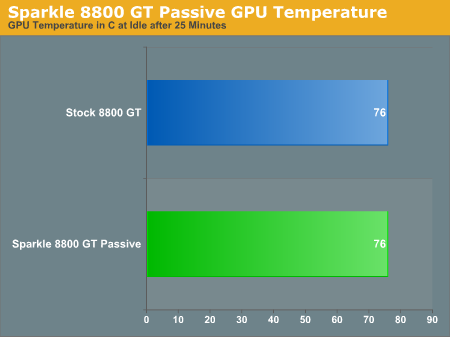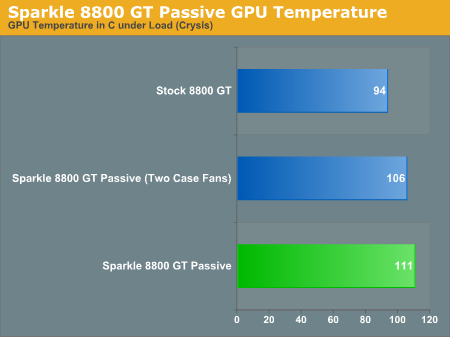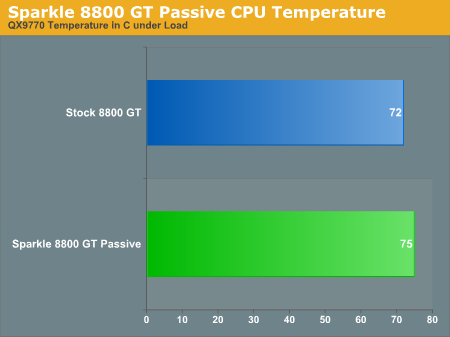Sparkle 8800 GT Passive: The Fastest Silent GPU in the World
by Anand Lal Shimpi on November 29, 2007 12:00 AM EST- Posted in
- GPUs
Once again, Crysis was our benchmark of choice as it seems to put the greatest stress on GPUs. We played for hours on end until the GPU temperature leveled off, using nTune to monitor temperature levels from the GPU's on-die thermal diode. Note that playing Crysis actually got these GPUs hotter than looping the 3DMark '06 HDR/SM3 tests, although only by 1 - 2C.

Interestingly enough, at idle, both the stock 8800 GT with its fan and the Sparkle passive card reach about 76C. The only explanation is that the 8800 GT's fan is designed to remain as quiet as possible, so it doesn't actually do all that much cooling when the GPU isn't being stressed.

Running Crysis, the stock 8800 GT's GPU peaks at around 94C with the two 80mm case fans in the system unplugged. The passively cooled Sparkle in the same situation is already at 111C, an increase of 17C, not nearly as much as we honestly expected but still quite hot.
Turning the case fans on drops the GPU temperature to 106C, showing that airflow in the chassis is important.

The impact on CPU temperature was actually marginal, the hottest of the four cores of the QX9770 only saw a 3C increase in core temperature.
Despite our best efforts, the Sparkle 8800 GT Passive prevailed, although posting some worryingly high GPU temperatures the card never crashed during our tests.










55 Comments
View All Comments
darshahlu - Thursday, November 29, 2007 - link
Interesting article.111C seems a bit hot doesn't it? I don't think I would feel comfortable running any component in my computer at that temperature. Not only is it a fire and burn hazard as joked by the author, the temperature will negatively effect the life and stability of all other components. While I definitely agree that noise elimination is very important in computer design, if you are really concerned with noise you will likely go for a much cooler card, which won't increase overall ambient temperature of your case. I would be more impressed with a slower card that ran extremely cool.
I have an AMD Opteron w/ a huge Zalman heatsink. No case fans and all inlets covered up w/ acoustic damping material. PSU has an adjustable fan, which I always run on its lowest setting. Three hard drives: 1 10k Raptor for OS, two 1 terabyte WD green power drives running RAID mirror for redundant storage. The entire inside of my steel full tower case is lined with acoustic damping materials. The hottest component in my computer is my motherboard chipset, which runs at 130 F. (This is after I replaced the chipset fan/HS and applied arctic silver.) My CPU runs at 90 F, only 20 degrees hotter than ambient room temperature, and likely only a few degrees hotter than the inside of the case (I have cool and quiet enabled to throttle the CPU by 50% when idle). GPU is a 6600 or something, passively cooled. Never gets too hot to touch.
If I were to add an 111C component to my computer, every thing else would increase in temperature, and likely, I would have to add case fans/noise to keep things in control.
Darshan
qamca - Sunday, January 20, 2008 - link
Well, it occurs to me that the authors of this article have no intention on getting the coolest, but in somewhat beating the record of highest temperature out of this configuration....And if your PC case is so small and in such a mess and so crowded, I don't see why would anyone buy a passive cooled performance graphics card like this one... In fact I don't see why would anyone build any performance configuration in a case like this one??
Another test I read has successfully overclocked this card to 695/2000 without reaching 85C.
All you need is a tidy case and a well thought trough airflow in it.
So keep your pants on all you people scared of getting burned...
Griswold - Friday, November 30, 2007 - link
Its 111C inside the GPU core and not at the heatsink. Thats not really a fire or burn hazard.crazytyler34 - Friday, November 30, 2007 - link
100C boils water! when was the last time you touched boiling water without being burned?gerf - Saturday, December 1, 2007 - link
Again, you can't touch the GPU itself, only the heatsink. The heatsink is relatively cool compared to the GPU itself.The GPU is the source of the heat, and is naturally the hottest point. That heat is transferred to the heatsink (it sink the heat, see?), which cools down much faster than the GPU alone, due to large amounts of surface area. If there's enough airflow, the GPU could be 120C, and the heatsink (the area you can reach to touch) would be the same as room temperature.